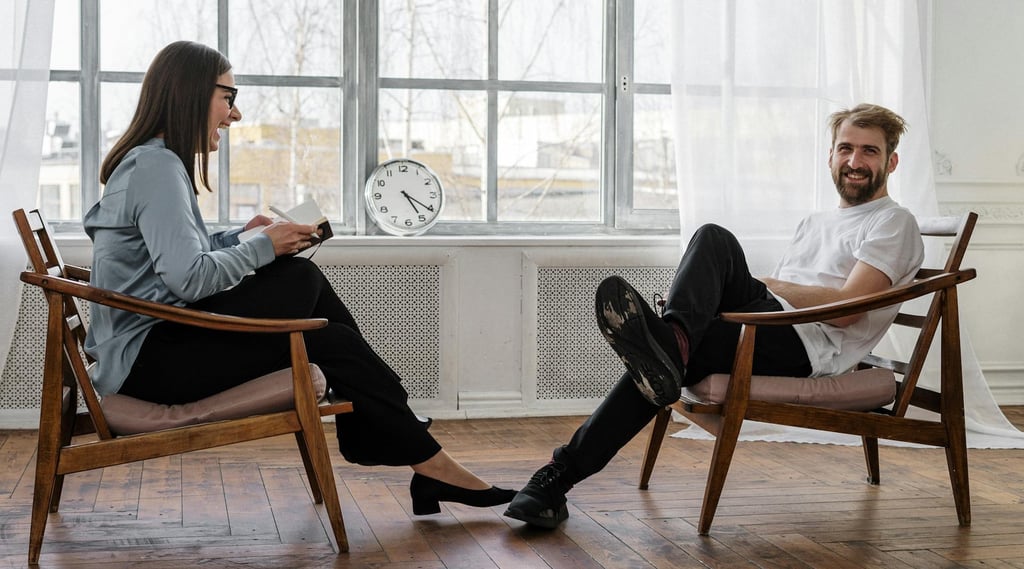Learning Intimacy Through Somatic Coaching: A Client Interview
I wanted to know what working with me was like for my clients. So I interviewed one. Here’s what he had to say about working with a somatic sex coach.
Rachel Moore
11/11/20246 min read


Photo by cottonbro studio: https://www.pexels.com/photo/2-women-sitting-on-brown-wooden-chair-4101137/
Peter is a recently divorced man who came to me for help with dating. When we first started working together his goals were to get help navigating the dating pool and learn what he could do better to get improved results.
At our first session, I realized that Peter was expecting a dating coach like he’d seen in the movies. Someone who would tell him what to say and how to act in order get more dates. As he soon found out, that’s not what I do with my clients.
When I met Peter I found him to be driven, focused, and highly motivated to “fix” whatever he was doing wrong. This goal-oriented behavior had clearly served him well in the other areas of life. Understandably, he was confused when I suggested we spend our first few sessions learning to slow down his breathing and bring more awareness to our interactions.
I chose this starting point because my nervous system reacted strongly to Peter’s. When we sat down together, I felt overpowered by his energy. I couldn’t seem to get a good feel for what was going on with him. I wanted to connect, but it was difficult to find a way in without feeling that he was attuned to me and present for our interactions.
When I helped him slow down, he could feel for himself how much better conversation and touch felt in that state. We began to warm up to each other.
Next, I helped Peter understand how to connect better with me specifically, not a generic “woman.” I bring my whole self to my client sessions. As our coaching relationship grew, I could tell him when our interactions made me feel more open to him and when our interactions pushed me away.
This is the “relationship lab” part of coaching. Therapists and most other coaching professionals are neutral observers of their clients. This is an important quality for a lot of healing work. But it isn’t very helpful for teaching the skills of intimacy. By being in a therapeutic relationship with me, my clients learn what a healthy relationship feels like.
Below is how Peter describes how he learned to understand the difference:
I knew something about dating, and I knew that I was messed up with it, but I didn't have any framework for it. My experiences with professional help have always been after having some limited success or with, with that area like tennis or pickleball, I would hire someone to give me pointers to improve. And so, my expectations were that I would find someone that would, provide me with guidance in how to navigate dating in the same way. So in a sense, my, desires were not in alignment with the process.
This is not how to sell better in five easy steps, right? The concept that is put out there is, if you follow my five steps or if you do these three things, you can have any woman you want. That with the magic phrase, alakazam, (you can get whatever you want.) And, of course, leads to huge disappointment, but also leads to just this false expectations.
Besides, that's more of the how can you trick your way into her pants as opposed to how can you find somebody that's a good match for you that's going to be lasting and fulfilling?
To help Peter connect with me, I had to help him connect better with himself. As we worked together, I noticed that he was using a shotgun approach to his interactions: connecting with as many women as he could, and then aggressively pursuing any of them that responded. Instead of helping him connect with even more woman in an effort to improve his “odds”, I tried to help him notice what was going on inside of him during these interactions. Did he feel that he was being welcomed, or did he feel like he was putting in all the effort to get closer?
One tool we used was demonstrating what my energy and approach is like in three scenarios. First, when I’m polite but closed off. Next, I move to friendly and open before I demo being excited and wanting more. Because I was able to “freeze” our interactions and point out the subtle differences in them, Peter quickly recognized the differences. He’d already felt it happening, but didn’t know what it meant or how to respond. Here is how Peter explained the impact:
Well, one of them is a greater understanding of the other person's perspective on things. Previously, I was aware if I was being, somewhat rude or forceful or pushy in interactions. I'm not talking about dating interactions now. I'm just talking about in general. And now I'm much more aware of how my interactions affect the other person's reaction.
And when I approached dating, I was doing it from the standpoint of trying to get the outcome that I wanted. That wasn't very productive, and I recognized that it wasn't productive, which is one of the reasons that I sought help. I didn't realize why it wasn't being productive. And so, the thing that I've noticed is by changing my goal of being present and being, in the moment, I'm having a better outcome.
We also worked together on helping him understand how his excitement and “pushy” energy can have the opposite effect on women than he intended. When he did or said something in a session that “pushed” me, I could feel my own body tense up.
These are the hardest parts of the coaching for me. Like most women, I was socialized to believe that it’s better to be uncomfortable yourself than to make others uncomfortable. As a result, I would have distanced myself from Peter when I felt that discomfort without telling him why had it been a real-life relationship.


Photo by Kenneth Surillo:
Instead, we used my discomfort as a learning tool. When I was feeling a desire to retreat, I told him. Because of the safety we had built in our relationship already, I could be vulnerable myself and shared some painful experiences of dating as a woman. This really shifted our relationship. Instead of driving me away with excitement, Peter was able to draw me closer to him with empathy. Here he shares an example of how this changed his approach with a woman he was interested in.
I'm more much more aware of what the other person is feeling. I have the specific example of being at a speed dating event. It was weird because I knew at the end of the event that there was a woman that I was interested in.
(As our interactions continued), she was nice enough to me and friendly enough. But I just knew that it wasn't gonna go anywhere. (This awareness) was there, but it was sort of muted before. You've made me much more aware of it and responsive to it. And all of a sudden now, I wouldn't say I'm that hypersensitive, but I'm much more aware of it. So when I have interactions with women specifically, I'm aware of them sort of backing off in a, emotional energy sense. And before, I would just sort of push forward and, just keep going without recognizing that they were backing off or being aware of the impact I was having by pushing forward.
A somatic approach to intimacy is so powerful because the emotions and experiences we share are real. When someone can understand something in their mind and feel it in their body, it becomes a tangible tool instead of an abstract concept. As Peter was able to integrate our sessions into his understanding of relationships through this process, he was able to see what was going on in his relationships more clearly.
Working with you has been enlightening...It's almost it's almost like seeing more of the process. It's like the difference between VHS and Blu Ray. It's the same content, but there's so much more material and so much more detail involved in a Blu Ray image. Right? There's so many more pixels and so much more clarity.
I’d like to thank Peter for being brave enough to share his coaching experiences with a larger audience. So many men feel shame when they struggle find a romantic partner. Our society says that being successful at dating is the biggest indicator of success in life. Even reaching out to a coach can feel like admitting that you are a failure. By willingly sharing his own experiences publicly, Peter is rejecting that shame and making it easier for other men to do the same.
If you’re interested in learning more about working with me, fill out this form and I will reach out to set up a discovery call.
This was first published on my free substack newsletter.
TONICFORLIFE@PROTON.ME
